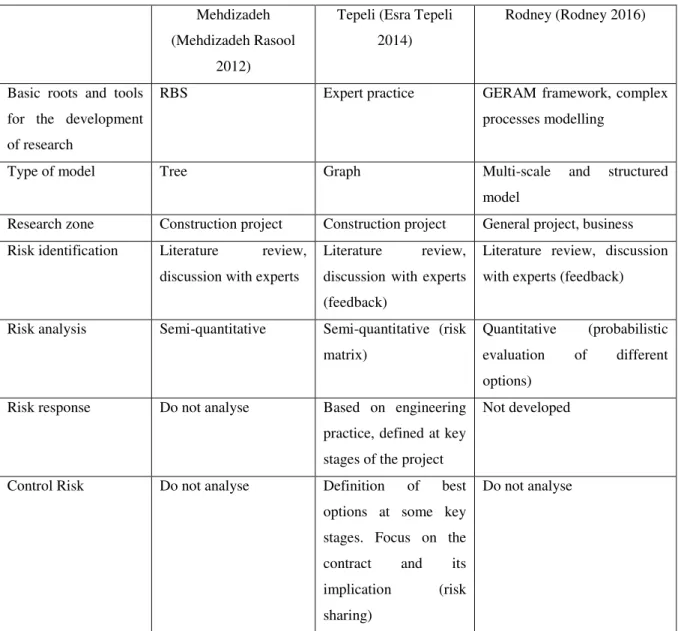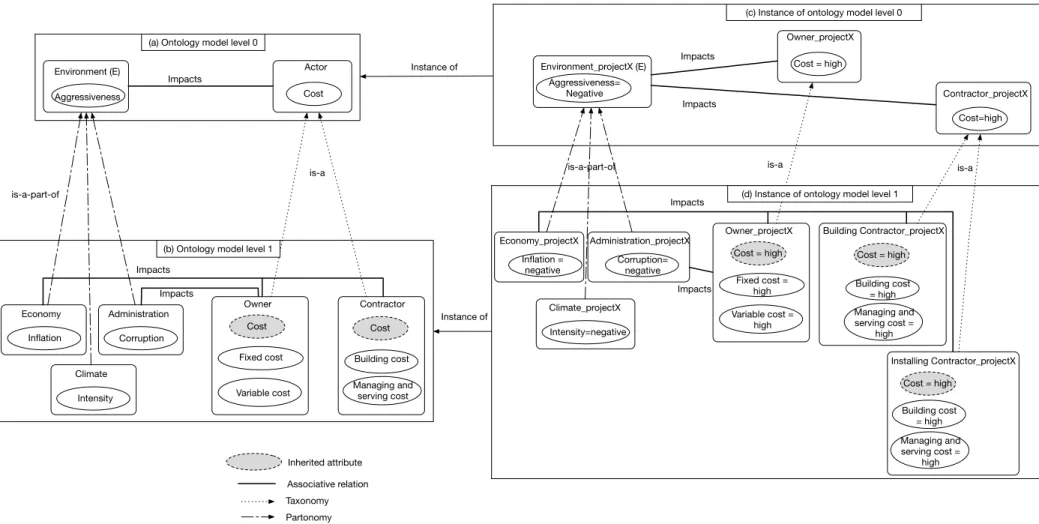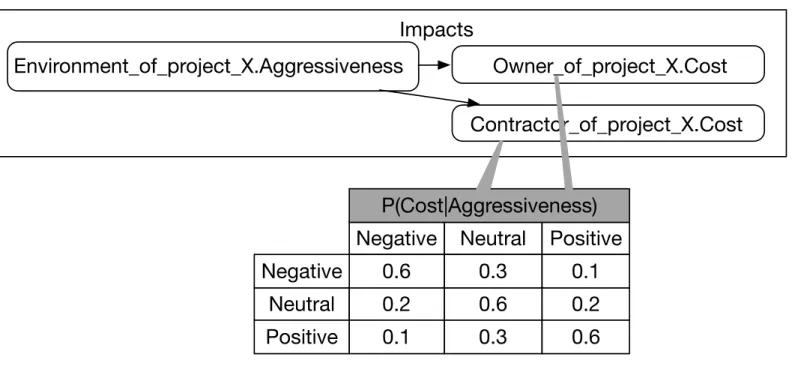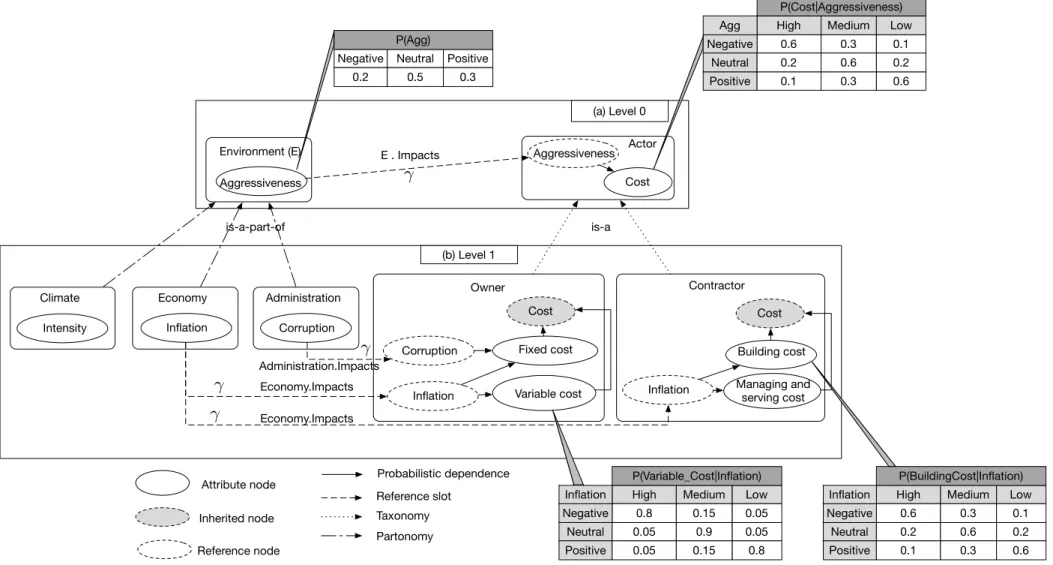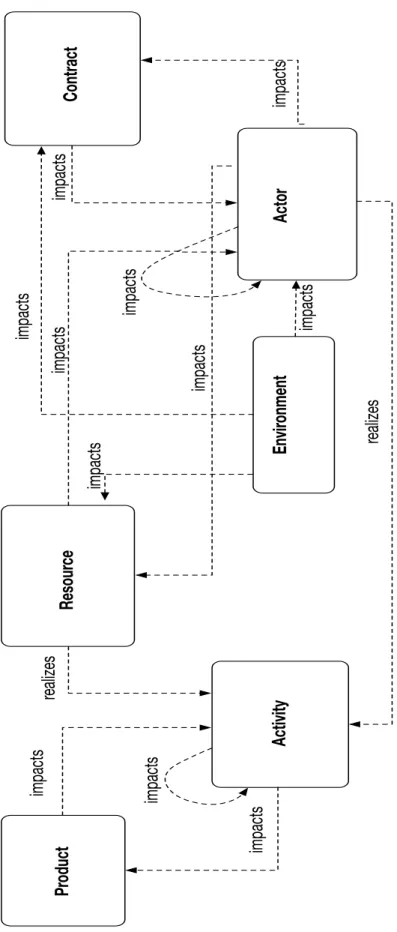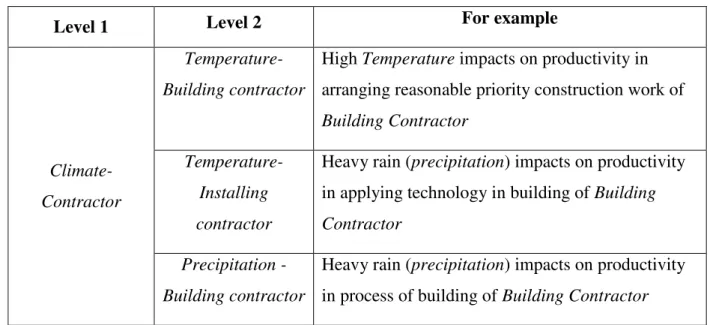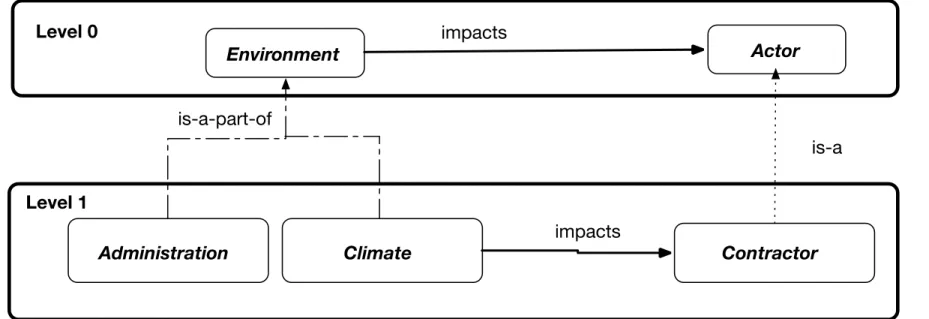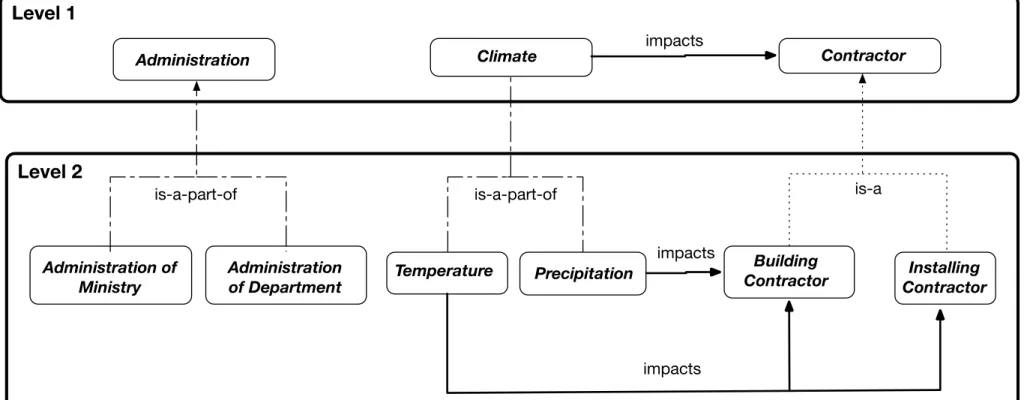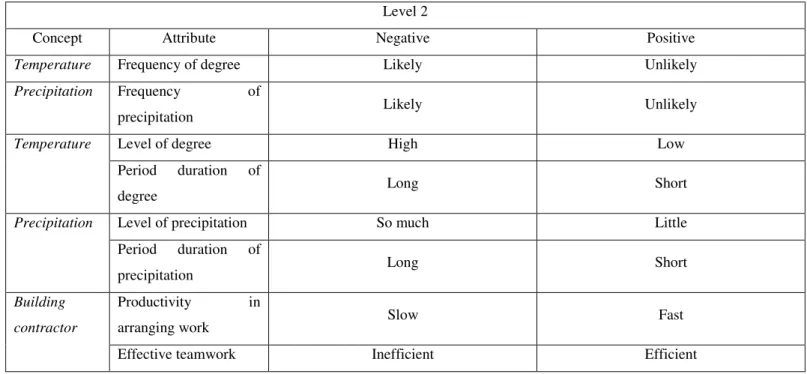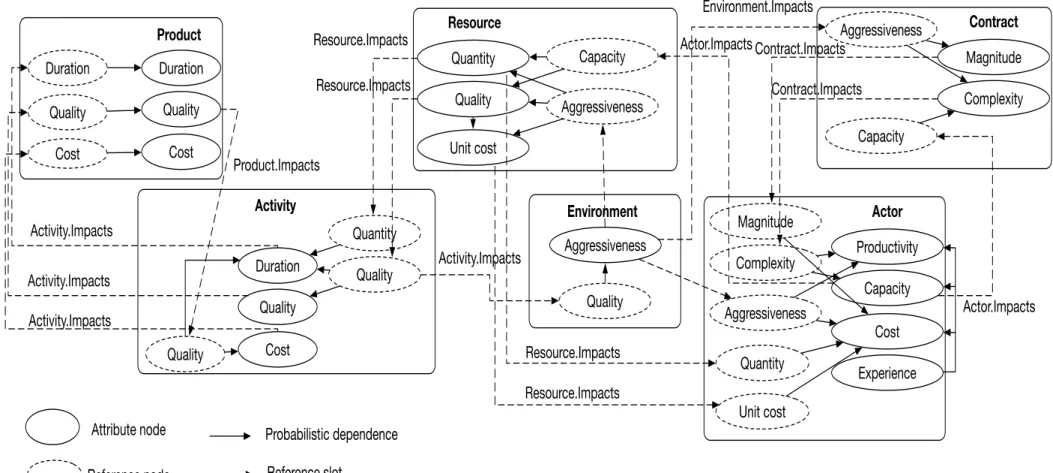HAL Id: tel-01782409
https://tel.archives-ouvertes.fr/tel-01782409
Submitted on 2 May 2018
HAL is a multi-disciplinary open access
archive for the deposit and dissemination of sci-entific research documents, whether they are pub-lished or not. The documents may come from teaching and research institutions in France or abroad, or from public or private research centers.
L’archive ouverte pluridisciplinaire HAL, est destinée au dépôt et à la diffusion de documents scientifiques de niveau recherche, publiés ou non, émanant des établissements d’enseignement et de recherche français ou étrangers, des laboratoires publics ou privés.
Représentation et simulation de projets de construction
entachés d’incertitudes en utilisant des modèles
relationnels probabilistes
Thi Thuy Phuong Tran
To cite this version:
Thi Thuy Phuong Tran. Représentation et simulation de projets de construction entachés d’incertitudes en utilisant des modèles relationnels probabilistes. Mécanique [physics]. Université de Bordeaux, 2018. Français. �NNT : 2018BORD0014�. �tel-01782409�
Abstract
The difficulty to manage risks in construction projects comes from their complexity. They are composed of many entities (activities, actors, contracts, resources, etc.) among which interactions exist at many levels and influence the system response. In turn, this response can influence the behaviour of some entities. In order to capture the complexity of the system, it is necessary to structure, model and share cross-disciplinary and interdisciplinary knowledge flows in a common and unifying framework. Because of this high complexity, the system response may appear as unpredictable. Uncertainties at all scales are source of risk for the construction project itself. Tackling this complexity could improve our grasp of the whole system, in order to provide more robust and efficient decision alternatives in risk management. It is then essential to propose conceptual approaches able to represent the behaviour and the interactions of system entities over the time.
Different approaches and tools have been proposed to model and simulate risk of construction project as Risk Breakdown Structure, Bayesian networks, Network Theory, Monte Carlo Simulation, Analytical Network Process, etc. These tools and methods can be used to simulate the behaviour of the system, but they are inadequate for representing large and complex dynamical system because they are based on case-dependant model (i.e. a specific model has to be built for each studied construction project), the fragmented representation of knowledge, the lack of common vocabulary, the lack of generic character. Hence, an ontology paradigm is developed in order (a) to provide a common vocabulary able to represent the knowledge about construction projects and its risks, (b) to shape the structure (interrelations) between those identified database and (c) to represent construction project integrating as well technical, human, sustainability dimensions at different detailed levels of uncertainty.
In this context, by coupling the advantages of ontology and Bayesian network, the framework of probabilistic relational model (PRM) will provide a practical mathematical formalism allowing to represent and simulate complex stochastic dynamical systems. PRMs extend the formalism of Bayesian networks by adding the notion of object paradigm where uncertainty attached to the system is then taken into account by quantifying probabilistic dependence between the properties of objects and other properties of related objects. To the best of our knowledge, this thesis report will be the first application in which PRM have been proposed to model and simulate construction project while accounting uncertainties.
Therefore PRM is used to simulate the propagation of uncertainties existing in this complex dynamic and multi-scale system, which lead to construction project risk. A prototypal software framework has been developed to check the consistency and the viability of the concept. It will be shown how it can be used in order to predict the uncertain response of the system as well as to study how the overall response of the system is sensitive to local values or assumptions. Lastly, PRM will be applied for two case-studies (a road and bridge construction in Hue-Vietnam and another building project in France). Results show that the formalism of PRMs allows to (1) implement any kind of construction project, (2) to take uncertainty into account, (3) to simulate and predict the behaviour of system and (4) to derive information from partial knowledge.
Key words: Complex system, Construction project, Probabilistic relational model (PRM), Uncertainty modelling, Knowledge base.
Résumé
La gestion des risques est un enjeu majeur, mais difficile pour les projets de construction. La difficulté à gérer les risques dans les projets de construction vient de leur complexité. Ils sont composés de nombreuses entités (activités, acteurs, contrats, ressources,
etc.) dont le comportement collectif influencent les comportements individuels. Afin de
mieux appréhender et comprendre la complexité du système dans son ensemble, il est nécessaire de capitaliser et structurer la connaissance dans le but de proposer un modèle capable de décrire et simuler le comportement du système étudié. Cependant, la formalisation de tels modèles se confronte à de nombreuses difficultés : présence de facteurs humains, raretés de modèles, connaissances souvent expertes et qualitatives difficiles à formaliser, méconnaissance des mécanismes régissant certains processus, données parcellaires, hétérogènes et souvent imparfaites, échelles multiples, etc. L’objectif est de proposer des approches conceptuelles permettant d’assembler des morceaux de connaissances hétérogènes multi-sources et multi-échelles dans le but de proposer un modèle capable de réduire les incertitudes liées au fonctionnement, au devenir, à la conception et au pilotage des projets de construction.
Différentes approches et outils ont été proposés pour modéliser et simuler les projets de construction : structure de répartition des risques, réseaux bayésiens, théorie des réseaux, simulation de Monte Carlo, réseau analytique, etc. Ces outils et méthodes sont utilisés pour simuler le comportement de systèmes, mais inadéquats pour représenter des systèmes complexes dynamiques à grandes échelles. Ils sont pour la plupart parcellaires et ne présentent pas ou peu de généricités. Dans ce contexte, les modèles relationnels probabilistes (MRPs) fourniront un formalisme mathématique pratique permettant de représenter et de simuler des systèmes dynamiques complexes entachés d’incertitudes. Les MRPs étendent le formalisme des réseaux bayésiens en ajoutant la notion de paradigme objet où l'incertitude attachée au système est alors prise en compte en quantifiant la dépendance probabiliste entre les propriétés des objets.
Pour ce faire, une ontologie du domaine a été développée pour (a) fournir un vocabulaire commun capable de représenter les connaissances sur les projets de construction, (b) identifier les interconnections entre les différentes entités techniques, humaines, économiques à différents niveaux de description. Guidé par cette ontologie un
MRP a été élaboré et utilisé pour simuler le comportement des projets de construction tout en prenant en compte les incertitudes. On montrera comment il peut être utilisé pour prédire la réponse incertaine du système ainsi que pour étudier comment la réponse globale du système est sensible aux valeurs ou hypothèses locales. Enfin, le MRP sera utilisé pour deux études de cas (la construction de routes et de ponts à Hue-Vietnam et d’un bâtiment en France). Les résultats montrent que le formalisme des MRPs permet (1) d’instancier tout type de projets de construction, (2) de prendre en compte l'incertitude, (3) de simuler et prédire le comportement du système et (4) d’extraire de la connaissance à partir d’informations partielles.
Mots clés : Système complexe, Projet de construction, Modèle relationnel probabiliste, Modélisation d'incertitude, Base de connaissances
Acknowledgment
With the support of financement of Vietnamese government, I had a great chance to research under the guidance of Prof. Denys Breysse, Dr. Franck Taillandier, and Dr. Cédric Baudrit. Their guidance, patience, and motivation helped me in all the time of researching and writing of this thesis. I could not have imagined having better advisors and mentors for my Ph.D study.
First of all, my sincere thanks goes to my professor Denys Breysse for his kindness, and clear advices on scientific research orientation during my thesis. He also gave me a strong motivation in learning French.
Besides, I would like to thank Dr. Franck Taillandier and Dr. Cédric Baudrit for their insightful comments and encouragement. During three years of thesis, they help me from the first step of writing a basic scientific paragraph to code a program that I’ve never known before. Working with them, I learnt scientific work style and work organization.
I thank my fellow labmates at I2M laboratory with whom I have pleasure to work and for all the fun we have had in the last three years.
The most important is my family. My mother sacrified all of her life for me and gave the best thing to make me comfortable during three years. I believe that my father in paradise will be happy about all the things I’ve done. I would like to thank my husband, LE Xuan Sang, and to my daughter, Uyen Nhi, for supporting me spiritually throughout writing this thesis and my life in general.
I respect and love you all with all my hearts. TRAN Thi Thuy Phuong.
TABLE OF CONTENTS
Introduction ... 9
Chapter 1 ... 17
State-of-the-art about risk management in construction project and formalism to model complex system tainted with uncertainty ... 17
1.1. State-of-the-art of risk management in construction project ... 19
1.1.1. Construction project ... 19
1.1.1.1. Definition and characteristic ... 19
1.1.1.2. Components ... 20
1.1.1.3. Performance of construction project ... 21
1.1.2. Risk management ... 22
1.1.2.1. Risk definition ... 22
1.1.2.2. Risk management principles ... 23
1.1.2.3. Application of risk management ... 28
1.1.3. Tools and model for risk management ... 28
1.1.3.1. Operational risk management tools ... 28
1.1.3.2. Risk management model for construction project ... 31
1.1.4. Other current models ... 35
1.2. Conceptual framework for uncertainty analysis ... 36
1.2.1. Semantic knowledge model ... 36
1.2.1.1. Concepts, attributes, and relations ... 37
1.2.1.2. Instantiating ontology ... 38
1.2.2. Bayesian networks ... 42
1.2.3. Probabilistic relational model (PRM) ... 43
1.2.4. Hierarchy and specialization extension ... 48
1.3. Conclusion ... 51
Chapter 2 ... 53
Development of a holistic generic model to formalize construction project ... 53
2.1. Introduction ... 55
2.2. Concepts ... 56
2.3. Relations between concepts ... 60
2.4. Attributes ... 66
2.5. Relation between attributes ... 74
2.6. Conclusion ... 78
Chapter 3 ... 79
From Ontological model to PRM for construction project ... 79
3.1. Introduction ... 81
3.2. Calculation method in PRM of construction project ... 81
3.2.1. Defining the scales of attributes’ value ... 81
3.2.2. A priori probability ... 82
3.2.3. Conditional probability tables (CPTs) ... 82
3.2.4. Aggregation operator ... 87
3.2.5. V-structure transformation ... 88
3.3. Implementation... 89
3.3.1. Implementation of the Construction Project PRM via O3PRM ... 90
3.3.2. Optimization strategies ... 91
3.3.2.1. Calculation time ... 91
3.3.2.2. Optimization strategy to solve time calculation problem ... 92
3.3.3. Accelerating model inference using Clustering computing ... 92
Chapter 4 ... 95
Application in case studies ... 95
4.1. Introduction ... 97
4.2. Case study 1 application (Road and bridge project 2BS)... 97
4.2.1. Project presentation ... 97
4.2.1.1. Environment of project 2BS (instances of Environment in level 2) ... 99
4.2.1.2. Actor of project 2BS ... 99
4.2.1.3. Contracts in project 2BS ... 101
4.2.1.4. Activities in project 2BS ... 102
4.2.1.5. Resources in project 2BS ... 103
4.2.1.6. Products of project 2BS ... 104
4.2.2. Instantiated model (skeleton) ... 105
4.2.3. Results and discussion ... 107
4.2.3.1. Sensitivity analysis of the Building_project2BS in some governing factors 108 4.2.3.2. Sensitivity analysis of the PIP2BS_Building.Duration regarding different scenarios correspondent with priori attributes in level 1 ... 110
4.2.3.3. Simulation of the influence of some real-time decision during the project in macro level (level 0) ... 112
4.2.3.4. Analysing of the Building.Duration2BS regarding different scenarios correspondent with level 1 and 2. ... 114
4.3. Case study 2 application (nursing training institute) ... 116
4.3.1. Project presentation ... 116
4.3.2. Instances of project NTI (instances of project NTI in level 2)... 117
4.3.3. Instantiated model (skeleton) ... 120
4.3.4. Results and discussion ... 123
4.3.4.1. Simulation of the influence of some real-time decision in the macro-meso model 123 4.3.4.2. Analysing the consistency of product of project NTI between the three levels 127 4.4. Results and discussion ... 132
Appendix ... 143
Appendix 1. Developed ontology in construction project ... 143
Appendix 2. Entities, attributes, and their significations in level 1 ... 160
Appendix 3. Entities, attributes, and their significations in level 2. ... 170
Appendix 4. Concepts’ relations in level 1 ... 208
Appendix 5. Concepts’ relations in level 2 ... 211
Appendix 6. Attributes’ relations in level 0 and their signification... 221
Appendix 7. Attributes’ relations in level 1 ... 223
Appendix 8. Attributes’ relations in level 2 ... 240
Appendix 9. Signification of attributes’ states in level 2 ... 315
Appendix 10. List of instances in level 1 of project 2BS. ... 343
Appendix 11. List of instances in level 2 of project 2BS ... 344
Appendix 12. List of instances in level 1 of project NTI ... 349
Appendix 13. List of instances in level 2 of project NTI ... 350
Appendix 14. Specific instances’ relations in level 0 project 2BS ... 353
Appendix 15. Specific instances’ relations in level 1 project 2BS ... 355
Appendix 16. Total relation of instance in Level 1 ... 369
Appendix 17. Specific instances’ relations in level 2 project 2BS ... 370
Appendix 18. Specific instances’ relations in level 0 project NTI ... 413
Appendix 19. Specific instances’ relations in level 1 project NTI ... 416
Appendix 20. Total relation of instance in Level 1 ... 425
LIST OF TABLES
Table 1-1: Advantage and disadvantage of each method of risk identification (Project
Management Institute 2008). ... 29
Table 1-2: Correspondent works in each phase risk management of construction project of recent works in laboratory I2M. ... 33
Table 1-3: Advantages and disadvantages of recent works in laboratory I2M. ... 33
Table 1-4: Our direction based on existing problem of precedent research. ... 34
Table 2-1: Main concepts in the model ... 56
Table 2-2: Finer concepts of level 1 and 2. ... 59
Table 2-3: Correspondent concepts’ relations in level 2 of relations Climate-Contractor in level 1. ... 63
Table 2-4: 16 descriptive attributes of concepts in level 0. ... 67
Table 2-5 : Definitions of some of attributes in level 1 and 2 ... 72
Table 2-6: Signification negative and positive states of some attributes of Environment and Actor in level 2. ... 73
Table 2-7: Relations between attributes and their example in level 0. ... 76
Table 2-8 : Inheritance relations between Actor.Cost and Activity.Cost from level 0 to level 2 ... 78
Table 3-1: Examples of a CPT which model the relation between Activity.Cost and Product.Cost ... 83
Table 3-2: Consistent pre-designed CPT ... 84
Table 3-3 : Antagonist pre-designed CPT ... 84
Table 3-4 : Characteristics of eight default matrices. ... 85
Table 4-1: Sources of instance’s information and chosen instances. ... 98
Table 4-2 : Instances of Activity and Actor involved in feasibility phase. ... 102
Table 4-3 : Instances of Activity and Actor involved in implementation phase. ... 102
Table 4-4 : Instances of Activity and Actor involved in operation phase. ... 103
Table 4-5 : Instances of human in project 2BS. ... 103
Table 4-6: Instances of machine in project 2BS. ... 104
Table 4-7 : Instances of Product of project 2BS. ... 104
Table 4-8: Instances of entities in level 0 ... 105
Table 4-9 : Scenarioproject and Scenarioproject+ of project 2BS ... 113
Table 4-10 : Instances of Activity and Actor in feasibility phase. ... 118
Table 4-11: Instances of Activity and Actor in implementation phase. ... 118
Table 4-12: List of human of project NTI. ... 119
Table 4-13 : Instances of machine in project NTI ... 119
Table 4-14: Instances of products of project NTI (generic and instantiated). ... 120
Table 4-15: Instances of entities in level 0 ... 120
LIST OF FIGURES
Figure 0-1 : Outline of thesis ... 15
Figure 1-1: (a), (b) Example of an ontology structure level 0 and 1 by using a graphic representation, (c), (d) Example of instantiations level 0, 1 of ontology model. ... 41
Figure 1-2: A basic BN ... 42
Figure 1-3: Example of a Bayesian network ... 42
Figure 1-4: Example of a PRM structure based on knowledge model ... 46
Figure 1-5: An example of a skeleton associated with the PRM structure. ... 47
Figure 1-6: Equivalent ground Bayesian network stemming from the skeleton and the PRM structure. ... 47
Figure 1-7: Example of a PRMs structure based on knowledge model describing two levels of knowledge ... 50
Figure 2-1 : Order of works in chapter 2 ... 56
Figure 2-2 : List of concepts relate to Environment which create uncertainties in construction project ... 59
Figure 2-3: List of words relate to sub-concepts of Climate. ... 59
Figure 2-4: Ontological structure describing a generic representation of project construction at a meta-level. ... 62
Figure 2-5: (a) Relations between Environment and Actor in level 0, (b) Inherited concepts’ relations from level 0 to level 1 ... 64
Figure 2-6 : Hierarchical ontology model describing relation between Environment and Actor of construction project at level 2 which stem from figure 3-5 ... 65
Figure 2-7: Examples of inherited attributes in taxonomy (a) and partonomy relations (b) .... 66
Figure 2-8 : Relation network between the descriptive attributes in level macro-level ... 75
Figure 3-1: Simple example of attribute without parent A1. ... 82
Figure 3-2 : An example of priori probability P(A1), P(A2). ... 82
Figure 3-3: A sample of n Actor realizing the Activity Act1 of Acti ... 88
Figure 3-4 : Convergent connexion of node Y ... 89
Figure 3-5 : V-structure ... 89
Figure 3-6 : V-structure versus Transformed V-structure where A (resp. R) correspond to Actor (resp. Resource) ... 89
Figure 3-7 : Four main parts of code ... 90
Figure 4-1: Viewpoint of project through satellite. ... 99
Figure 4-2 : Relations between owner, designer, contractors and suppliers in project 2BS. . 101
Figure 4-3 : The relational skeleton using elements from Table 5 and the PRM model ... 107
Figure 4-4 : Marginal probability distribution of (a) the quality (b) the cost, (c) the duration of building of project 2BS, (d) the complexity of contract linking owner and designer, (e) the capacity of designer and (f) the quantity of human resource during the implementation phase given three scenarios: {EE.Agg=E} in grey, {EE.Agg=SSN} in black, {EE.Agg=SSP } in white where EE=environment. ... 110
Figure 4-5: Marginal probability distribution of PIP2BS_Building.Duration given correspondent five scenarios (a) Economy2BS.Inflation =SSN, (b) Administration2BS.Inertia =SSN , (c) Climate2BS.Intensity =SSN. ... 112
Figure 4-6: Marginal probability distribution of (a) the quality, (b) the cost and (c) the duration of building of project 2BS given scenarioproject. and scenarioproject+. ... 114
Figure 4-7: Marginal probability distribution of Building.Duration given correspondent two scenarios (a) Economy2BS. Inflation =SSN, (b) Economy2BS. Inflation =SSN, Climate2BS.Intensity =SSN. ... 115
Figure 4-8: Marginal probability distribution of BridgeLD.Duration_Of_Building given correspondent two scenarios (a) NationalEconomy2BS. IncreasingNationalTax =SSN, (b)
NationalEconomy2BS. IncreasingNationalTax =SSN, Temperature2BS. LevelOfDegree
=SSN ... 116 Figure 4-9 : Architecture perspective of Nursing training institute. ... 117 Figure 4-10 : Relations and contracts between owner, designer, contractors and suppliers in
project NIT. ... 118 Figure 4-11: The relational skeleton using elements from Table 5-16 and the PRM model
level 0 ... 121 Figure 4-12 : The relational skeleton level 1 of project NTI... 122 Figure 4-13 : Instances of product in level 0 and 1. ... 125 Figure 4-14 : Marginal probability distribution in level 1 of (a) the duration, (b) the cost and
(c) the quality of three instances (Detailed_DesignNTI, Regulation_DocumentNTI,
BuildingNTI) in level 1 of Product of project NTI when all attributes of instances of Environment are prior centred distribution (in black), all centred excepted climate SN (in
grey), and scenarioproject (in white). ... 126 Figure 4-15 : Marginal probability distribution through model covering level 1 and 0 of (a)
the duration, (b) the quality and (c) the cost of product of project NTI in level 0 given when all attributes of instances of Environment are prior centred distribution (in black), all centred excepted climate SN (in grey), and scenarioproject+ (in white). ... 127 Figure 4-16 :Comparing P(BuildingNTI. DurationOfBuilding|scenario) taken from level
micro-meso (grey column), meso level (white column). ... 130
Figure 4-17 : Comparing P(PIP. Duration|scenario) taken from meso-macro (grey column)
and macro level (white column) ... 130
Figure 4-18 : Input variables (light orange) and output variables (bright orange) attached with instances in 3 levels. ... 131 Figure 5-1: An example of simple model and CPTs in each level. ... 137 Figure 5-2 : ADP and ADCP. ... 138
- Context
Each project is a unique and temporary process that consists of many activities which are performed and controlled by actors to achieve requirements under the conditions of time, cost, quality (ISO 10006 2003). A construction project can be a process of alteration (adjustment), conversion, commissioning, renovation, maintenance, refurbishment, demolition, decommissioning or dismantling of a structure (safe work australia 2013).
Most construction projects do not reach their expected results regarding time, cost and quality, due to the internal and external environment variations (Love et al. 2002), as the impacts of human factors (Andrew R. Atkinson 1999), natural hazards (Middelmann 2007), technological hazards etc. Fails in construction project remain current like today’s:
- the ‘Philharmonie de Paris’ project that was delayed about 24 months and whose final cost exceeded the prior estimate by 276 M€,
- the budget of ‘Musée des Confluences’ in Lyons which changed from 61 M€ (initial cost) to 253 M€ (final cost),
- the ‘EPR de Flamanville’ project which was delayed in six years and current budget is more twice than initial one,
- the collapse of Can Tho Bridge (Vietnam) was a severe construction accident in September 2007, with 52 fatalities and the final cost is upper than 2 M€.
Construction projects are complex systems. They are composed of many heterogeneous entities (activities, actors, contracts, resources, etc.) among which interactions exist at many levels and influence the system response. In turn, this response can influence the behaviour of some entities. In order to capture the complexity of system, it is necessary to structure, model and share cross-disciplinary and interdisciplinary knowledge flows in a common and unifying framework. Tackle this complexity could improve our grasp of the whole system, in order to provide more robust and efficient decision alternatives in risk management. It is then essential to propose conceptual approaches able to represent the behaviour of system entities over the time.
Nevertheless, it is not an easy task given the heterogeneous character of the sources of knowledge and manipulated scales. Briefly, idea of suitable model should be able to deal with:
- heterogeneous sources of knowledge expressed by definition of vocabulary (based on perspective of technical experts, administrative, etc.),
- different formalisms used by different disciplines (equations, ontology, probabilistic models, relational graphs, cognitive maps, etc.),
- various manipulated scales (resource, human, worker, etc.),
- different forms of uncertainty (natural randomness, imprecision in expert opinions, data scarcity, etc.).
- Problematic
Different approaches and tools have been proposed to model and simulate risk of construction project as Risk Breakdown Structure (Mehdizadeh Rasool 2012), Bayesian network ((Rita L. Sousa and Einstein 2012), (Spackova, Sejnoha, and Straub 2013), (Wu et al. 2015)), Network Theory (Fang et al. 2012), Monte Carlo Simulation (Patterson and Neailey 2002), Analytical Network Process (Boateng, Chen, and Ogunlana 2015), Fuzzy logic ((Case and Chrysostomos D. Stylios 2016), (Nieto-Morote and Ruz-Vila 2011)), etc. Depend on characteristics of the project (i.e. number of uncertainties that can influence to project), organization’s policy (i.e. community resistance, decentralization in management organization), project management strategy, risk attitude of the project team members, availability of the resources, etc., suitable tool(s) will be applied (Boateng, Chen, and Ogunlana 2015). These tools and methods can be used to simulate the behavior of the system, but they are inadequate for representing large and complex dynamical system because they are based on case-dependant model; i.e. a specific model has to be built for each studied construction project. Furthermore, Fidan and Dikmen (Fidan and Dikmen 2011) have pointed that developed models about risks suffer from (1) the fragmented representation of knowledge, (2) the lack of common vocabulary, and (3) the lack of generic character, i.e none approach presents a global view with an unified vocabulary in managing uncertainty; they suggested to rather use ontology paradigm to provide common vocabularies which form database about risk of construction project and to shape the structure (interrelations) between those identified database. Different ontologies were developed in the sector of construction project:
+ Diraby et al. (El-Diraby, Lima, and Feis 2005) developed an ontology into many levels for the construction domain allowing to share a common vocabulary (notions) and retrieval of information. There is an important point which was not mentioned in this paper is the lack of
describing the interrelations between those notions in each detailed level.
+ Sun et al. (Sun and Meng 2009) presented how taxonomies (about change causes and change effects) may be used by professionals to manage changes during the construction projects.
+ Tserng et al. (Tserng et al. 2009) developed an ontology-based risk management framework allowing the contractor to reduce risk threats during risk management procedures. + Jiang et al. (Jiang, Zhang, and Zhang 2013) provided an ontology-based semantic retrieval method to use projects' experience for risk management of construction project but their analysis was restricted to risks of cost overrun.
+ Issa et al. (Jia Niu and Issa 2015) developed a first version of a taxonomy (a part of ontology) to address actual construction contractual claim issues.
+ Zhong et al. (Zhong and Li 2015) developed an ontological and semantic model for construction risk knowledge formalization.
However, none holistic approach is proposed to represent construction project integrating as well technical, human, sustainability dimensions at different detailed levels of uncertainty. Although ontology allows to describe domain and to retrieval information, it is not capable of simulating the behaviour of the system while taking into account uncertainty.
By coupling the advantages of two previous approaches (ontology, Bayesian network), the framework of probabilistic relational model (PRM) (Getoor et al. 2007) provides a practical mathematical formalism that allows to represent and simulate complex stochastic dynamical systems. The network structure provides an intuitively appealing interface for human experts to model highly-interacting sets of variables, resulting in a qualitative representation of knowledge. Stochastic uncertainty attached to the system is then taken into account by quantifying dependence between variables by means of conditional probability distributions. Although there exists a substantial literature about risk management in civil engineering, and if a wide variety of tools and methods have been proposed to improve the risk management, we are not aware of any works where PRM have been proposed to model and simulate construction project while accounting uncertainties.
In the model building process, different challenges must be overcome. First, construction project is a wide sector, it will exist many confusing and contradictory terminologies (i.e definitions). The first challenge consists in synthetisyng vocabulary and proposing clear and,
if possible shared definition, of the different notions related to construction project. Second, complex interaction between real things in a construction project. Hence, the next challenge is to propose interactions which are installed sufficiently and are suitable for any type of construction project.
- Objectives of thesis
The objective of this thesis is to propose an innovative and generic approach which is able to :
- represent and simulate the behavior of system of construction project, - take uncertainty into account,
- be reusable for any kind of construction project,
- applicate the proposed model in two case-studies to show the useful in simulating the behavior of construction project system.
This approach is based on the development of mathematical model relying on the formalism of PRM. The aim is to use this model to analyse and quantify risks deriving from all uncertainties existing in this complex, dynamic, and multi-scale system.
- Thesis outline
This thesis is organized as follows (figure 0-1):
- Part 2 will introduce the state of art regarding two topics: risk management for construction project and formalism to model complex system tainted with uncertainty. The first part presents and analyses main points about construction project, classification of risks, process of risk management, and tools which have been applied in risk management. The second part gives an overview about the conceptual framework for uncertainty analysis.
- Part 3 proposes a holistic generic model to formalize construction project. In this part, all of concepts, attributes and their relations in different detailed levels will be explained.
- Part 4 proposes a PRM for construction project based on the knowledge model exposed in part 3. In this part, PRM will be illustrated by specific examples. In order to support the PRM inference computations, the program O3PRM (Open Object-Oriented
Probabilistic Relational Model) will be introduced.
- Part 5 shows implementations of examples based on two real case-studies: a road and bridge construction in Hue (Vietnam) and a nursing training institute (France). This part shows how this approach can deliver quantified results and how they can be analysed.
Figure 0-1 : Outline of thesis
Introduction
Chapter 1
State of art about risk management in construction project and formalism to model
complex system tainted with uncertainty
Chapter 2
Development of a holistic generic model to formalize construction project
Chapter 3
From Ontological model to PRM for construction project
Chapter 4
Application in case studies
Chapter 1
State-of-the-art about risk management in
construction project and formalism to
model complex system tainted with
uncertainty
Contents
1.1. State-of-the-art of risk management in construction project 1.1.1. Construction Project
1.1.1.1 Definition and characteristic 1.1.1.2 Components
1.1.1.3 Performance of construction project 1.1.2. Risk management
1.1.2.1 Risk definition
1.1.2.2 Risk management principles 1.1.2.3 Application of risk management 1.1.3. Tools and model for risk management
1.1.3.1 Operationnal risk management tools
1.1.3.2 Risk management model for construction project 1.1.4. Other current models
1.2 Conceptual framework for uncertainty analysis 1.2.1 Semantic knowledge model
1.2.1.1 Concepts, attributes, and relations 1.2.1.2 Instantiating ontology
1.2.2 Bayesian network
1.2.3 Probabilistic relational model (PRM) 1.2.4 Hierarchy and specialization extension 1.3. Conclusion
1.1. State-of-the-art of risk management in construction project
The dynamic and instability of internal (actors, resources, etc.) and external environment (climate, economic, etc.) during the process of construction project are the reasons for unpredictable effects regarding time, cost, and quality of the project. Thus, in order to :
- understand clearly the behaviour of a construction project under the negative and positive influences of those impacts,
- manage objectives (time, cost, and quality) of construction project effectively, risk management will be our concerned.
Risk management is the topic of many researches (Baccarini and Archer 2001), (Zou, Zhang, and Wang 2007), (Rezakhani 2011), etc. with different tendencies. In order to find innovation direction about the propagation of risks in a construction project and its behaviour when uncertainties happen, we will analyse and synthesize recent research results about risk management of construction project. In a first step, we will analyse literatures and common practices regarding the concepts arising in construction project. Based on this analysis, we will propose a definition for each main concept.
1.1.1. Construction project
1.1.1.1. Definition and characteristic
Construction project consists of organized activities (Construction Work 2012) which perform construction works (construction, alteration, conversion, fitting-out, commissioning, renovation, repair, maintenance, refurbishment, demolition, decommissioning or dismantling of a structure). Construction work does not include: the manufacture of plant, the prefabrication of elements (ex. making precast concrete panels or roof), testing, maintenance or repair work of a minor nature carried out in connection with a structure (ex. testing or reparing a smoke detector, pressure piping, etc.).
In order to execute a construction project in a cost-efficient manner, effective time and quality under the fluctuation of environment, it requires the stringent planning and efforts of all stakeholders which participate in a construction project.
Definition: Construction project is a project which gathers many actors who use resources to carry out activities with the agreement with contracts to achieve requirements about time, cost and quality below the fluctuation of environment.
Main characteristics of construction project are listed in the table below:
- Each construction project (PMBOK 2013):
+ is unique in nature: Every construction project is different from others, whereas operational activities often involve undertaking repetitive (identical) processes,
+ has a defined timescale: it has a clearly specified starting and end date within which the deliverables must be produced to meet a specified customer requirement,
+ has an approved budget: it is allocated a level of financial expenditure within which the deliverables must be produced to meet a specified customer requirement,
+ has limited resources: at the starting time of a project, an agreed amount of resources (labour, machines, materials) is allocated to a construction project,
+ involves uncertainties,
- Construction works are conducted after orders through contracts.
- Construction activities are impacted by external environment (law, economic, …)
- There are potential impacts (internal or external) which can affect positively or negatively the objectives of construction project.
A construction project consists of many components. These components will be analysed in the next part.
1.1.1.2. Components
In order to build a generic model which can represent any type of construction project, many possible components has be taken into account to model the project. Based on literature review ((Mehdizadeh Rasool 2012),(Khartabil, Breysse, and Taillandier 2013),(Fidan and Dikmen 2011),(El-Diraby, Lima, and Feis 2005),(Tserng et al. 2009),(Sun and Meng 2009),(Jia Niu and Issa 2015),(Yildiz, Dikmen, and Birgonul 2014),(Franck Taillandier et al. 2016)) and our experience on construction project, six main components were defined : environment, actor, resource, contract, activity, and product.
- Environment: entities outside of project but which are susceptible to affect project. - Actor: individuals or organizations who perform activities and are linked by contracts. - Resource: assets that are used by actors to carry out activities of construction.
- Contract: legal documents which combine obligations and responsibilities of actors in performingactivities.
- Activity: actions which are performed by actors using resources. - Product: the results of activities which should satisfy predefined needs.
Under the impact of those components, the performance (success) of a construction project will be affect. Hence, the next part, the performance of construction project is our concern.
1.1.1.3. Performance of construction project
Project performance reflects the success of a construction project ((Meng 2012), (Cho, Hong, and Hyun 2009)). Several criteria were studied to state the issue of project success. Three criteria commonly form “the iron triangle” (time, cost and scope) of Atkinson (Atkinson 1999) and are considered crucial for project success. Chan et al. (Chan, Scott, and Lam 2002) and Robert et al. (Chinowsky, P.S. Meredith 2001) addressed that the time, cost and quality criteria were used to assess the success of construction projects. Moreover, “if a project is completed on time, within the agreed budget and set quality, then the project is deemed successful” (Garbharran and Govender 2012). In the paper of Kylindri et al. (Kylindri et al. 2012), time, cost and quality were also used to evaluate the success of a construction project.
Each objective (time, cost, and quality) has its own importance. About time, schedule delay is the time which overruns the date specified in a contract or agreement between parties in a construction project (Hossen, Kang, and Kim 2015). Schedule delay can lead to lawsuits between owner and contractors, increased costs (because of longer time working, extra labour cost, etc.), loss of revenue and contract termination (Hossen, Kang, and Kim 2015). About quality, it is regarded as the expectation of project participants and required standards. Because of failures of product (poor quality), more cost must be spent to repair. Hence, quality is an important object and needs to be considered along the whole life of project (Mallawaarachchi and Senaratne 2015). About cost, it is a primary concern for the vast majority of construction clients. The total cost cannot exceed the budget which is regulated in contract.
DEFINITION: The performance of the project is evaluated according to multi-dimensional criteria for each actor. This criteria covers at least three dimensions: quality of the product, time to delivery, and cost.
Performance or success of a construction project is not uncertainty because of risks which are created by its components. Hence, in order to control the performance of a project, we find out the way to manage risk in the next part.
1.1.2. Risk management 1.1.2.1. Risk definition
There are two sources which create risks: randomness of nature and lack of knowledge. Risk plays an important role in the success of construction project, i.e. it impacts project performance. As stated by Raz et al. (Raz, Shenhar, and Dvir 2002), risks can cause construction project delays, excessive cost, unsatisfactory quality of project’s product. In two main sources of risks, lack of knowledge of human being is more crucial than the other. Under the impact of nature, human being’s belief, attitudes, judgement, and feelings will decide the reaction to solve problems effectively in order to achieve time, cost, and quality as planned.
Depending on the viewpoint, experience, there are different significations of risk (Baloi and Price 2003). While risk measures both the uncertainty of a chance (positive) and a loss (negative) of a situation ((ISO 10006 2003), (Dziadosz, Tomczyk, and Kapliński 2015)). Ward (Ward 2003) argued that the term “risk” is often associated with adversity and focuses on threats, not opportunities. Barber (Barber 2005) defined risk as “a threat to project success, where the final impact upon project success is not certain”.
Risks are also attached with construction project processes and the product of project (ISO 10006 2003). Under impact of uncertainties, sometimes we get positive results, sometimes we get negative results. Risk is manageable, diminishable, transferable or acceptable but not ignorable (Bakr, El Hagla, and Abo Rawash 2012). When uncertainties happen, risk will propagate and cumulate through complex and multiple interactions in a construction project.
Definition: Risk in construction project is the uncertain consequence (negative or positive) of an event on project objectives. It lastly concerns the deviation between expectation and real value of time, cost, quality of the construction project.
Main characteristics about risk in construction project are listed in the table below:
- Risks are created by randomness of nature and lack of knowledge. - Risks can be positive or negative.
- Uncertainties appear at anytime of a construction project
- Important risks which affect to the performance of construction project must be reviewed and assessed.
1.1.2.2. Risk management principles
The purpose of systematic and practical risk management practices is to handle and manage risks so that the success of projects can be ensured. Thus, risk management process is a systematic application of management policies, procedures, and practices to the activities of communicating, consulting, context establishment, and identifying, analysing, evaluating, treating, monitoring, and reviewing risk (ISO 31000:2009). Risk management must maximize the probability and consequences of positive events, while minimizing the probability and consequences of adverse events regarding project objectives.
Risk management is a process based on decisions and/or actions of stakeholders which influence directly or indirectly the project performance. The construction project management involves numerous participants: owner, contractor, end users, promoters, construction companies, project designers, government/public bodies as well as a large number of sub-contractors, suppliers, etc. (Pérez, Gonzalez-Cruz, and Pastor-Ferrando 2010) whose interests and demands need to be considered in the managerial decision-making process ((Aaltonen 2011), (Akintoye and MacLeod 1997)). Moreover, each of those participants has a role in investigating, solving and/or cooperating with the others to manage risk effectively.
Many actors divided risk management into different phases (Berkeley, Humphreys, and Thomas 1991), (Elkington and Smallman 2001), (C. Chapman 1997), (Mehdizadeh Rasool 2012). Based on PMBOK Guide (PMBOK 2013) and ISO 10006-2003 (ISO 10006 2003), risk management process of construction project can be subdivided into four main phases:
- risk identification,
- risk analysis (qualitative, semi-quantitative, quantitative analysis), - risk response,
- control risk.
a/ Risk identification
Risk identification is the process of finding, recognizing, and describing risks (Hossen, Kang, and Kim 2015). It determines which risks might affect the project and documents their
characteristics (PMBOK 2013). In this phase, potential risks associated with a construction projects are identified (Zou, Zhang, and Wang 2007) through available scientific documents by using a consistent and structured method.
Two important aspects need to be taken into account during the identification of risks: - the way to identify risks. Identification of risks is a great challenge for researchers,
managers and practitioners (Guilan Shen, Fang, and Chen 2009). Experience and historical researches from previous papers or projects should be used for this purpose. - the way to determine relations between risks. The interactions between risks of
construction project always exist. Process of identifying relations between risk based on experiences.
Many stakeholders can participate in identifying risks of construction project: project manager, project team members, risk management team (if assigned), experts that are not members of the project, customers, end users, other project managers, stakeholders, and risk management experts (Mojtahedi, Mousavi, and Makui 2010). Chapman (R. J. Chapman 2001) pointed out that quality of risk identification affects directly the later phases of risk management. Risk identification has to be employed effectively to identify opportunities as well as threats.
b/ Risk analysis
Risk analysis analyses how often those events may occur and the magnitude of their consequences by using a wide variety of techniques (D. Cooper et al. 2015). Hence, the main inputs of risk analysis process are the identified risks from risk identification process. The probability and impact of identified risks are two main keys in assessing risk.
There exist many tools to analyse risk in construction project. The reasons to choose suitable tools are the familiarity with the techniques, lack of information and knowledge, suitability to applicate on construction project, the magnitude of construction project (Akintoye and MacLeod 1997).
In order to analyse risk efficiently, it is necessary to: model the dependencies between events, demonstrate the correlation between source events of an accident, consider all feasible accidents or failure scenarios and their related consequences, describe behaviour of the whole system, model the relationship between the context (environment and operational conditions)
and the probability of human and technical failures, characterize, represent and propagate uncertainties (Medina Oliva et al. 2009).
Risk analysis can be qualitative, semi-quantitative or quantitative ((Kollarits et al. 2009), (Taroun 2014a), (Serpella et al. 2014)).
- Qualitative analysis
The qualitative risk analysis is the “process of prioritizing risks for further analysis or action by assessing and combining their probability of occurrence and impact” (PMBOK 2013). In qualitative analysis, probability is the degree of belief that be hold in the occurrence and level of impact of an event.
A typical qualitative risk assessment usually includes (Kallman 2005): a brief description of the risk, the stages of the project when risk may occur, the elements of the project that could be affected, the factors that influence risk to occur, the relationship with other risks, the likelihood of risk occurring, and how risk could affect the project.
Methods are used in qualitative analysis are probability-impact matrix (PMBOK 2013), FMEA (Failure Modes and Effects Analysis) (Sai X. Zeng, Tam, and Tam 2010), etc. Probability-impact matrix is mainly used in an initial evaluation of risks or for a rapid assessment. This matrix can be used for assessing threats and opportunities using two grids of negative impacts (threats) and positive impacts (opportunities) ((Hillson 2002), (Liu et al. 2016)). Purpose of FMEA is to identify the potential failure modes and their consequences. This analysis is performed at the early stage of a project to take actions to reduce or eliminate failures.
- Semi-quantitative analysis
Semi-quantitative analysis contains a mixture of quantitative and qualitative data. It assigns numerical values to the description of risk from the qualitative analysis (Hossen, Kang, and Kim 2015). Some methods are suggested which involve both quantitative and qualitative data. For example, analytic hierarchy process method (AHP).
- Quantitative analysis
The quantitative risk analysis is the “process of numerically analysing the effect of identified risks on overall project objectives” (PMBOK 2013). Advantage of quantitative risk analysis is that it provides a measurement of the magnitude of impacts, which can be used for
further analysis and which produces quantitative risk information to support decision making in order to reduce project uncertainty ((PMBOK 2013), (Hossen, Kang, and Kim 2015)).
c/ Risk response
Outputs of risk analysis will be inputs for the risk response analysis. Risk response is a “process of developing options and actions to enhance opportunities and to reduce threats to project objectives” (PMBOK 2013). Strategy of risk response depends on stakeholders' risk attitudes and the specified constraints (budget, plan of stakeholders, etc.). There are two groups of risk response strategies: strategies for negative risks and strategies for positive risks (PMBOK 2013).
Strategies for negative risks consist of: avoid, mitigate, transfer, and accept.
- Avoid: changing project plans in a way that an identified risk is no longer relevant. It enables stakeholders to eliminate the threats that impact negatively on the construction project. Example of activities that can help to avoid potential risk (D. Cooper et al. 2015): more detailed planning, alternative approaches, protection and safety systems, operation reviews, training and skills enhancement, permits to work, procedural change, and preventive maintenance.
- Mitigate: finding ways to reduce the probability and/or impact of risk. Reducing the probability and/or impact before a risk occurs, will be more effective than trying to repair the damage after the risk has occurred (Ward 2003). Some projects invest in hiring experts to manage high-risk activities (Darnall and Preston 2007). Mitigation strategies can include (D. Cooper et al. 2015): contingency planning, quality assurance, separation activities and resources, contract terms and conditions, crisis management and disaster recovery plans.
- Transfer: transferring risks to other parties (Schieg 2006). Transfer of risk nearly always involves payment of a risk premium to the party taking on the risk (Ward 2003). “Transferring liability for risk is most effective in dealing with financial risk exposure” (PMBOK 2013). A risk can be transferred to another actor or organization who has a greater capacity.
As mentioned in Potts (Potts 2008), there are four common ways for the transfer of risk: + client to contractor,
+ contractor to subcontractor,
+ contractor or subcontractor to surety.
- Acceptance: making an informed decision to accept the likelihood and impact of a particular risk (Maley 2008).. For example: Project manager accepts particular risk like force majeure (flood, earthquake, etc…) or changes of state policy on finance or procedure.
In brief, avoidance and mitigation strategies mainly apply for critical risks with high impact, while transfer and acceptance are used for threats that are less critical and with low overall impact (PMBOK 2013). Akintoye et al. (Akintoye and MacLeod 1997) had a different viewpoint. They mentioned that risk acceptance becomes the only choice where other ones are impossible; i.e. when avoidance is undesirable, possible financial loss is small, probability of occurrence is negligible and transfer is uneconomic. So, depending on attitudes, experience, available conditions etc. of stakeholders, suitable strategies regarding negative risks will be used.
Strategies for positive risks consist of: exploit, enhance, share and accept.
- Exploit: increase the chance of a positive risk which the benefit is clear. For example: Before the project ends, there is a bid of another project (clear information). So, contractor tries to end the first project earlier than initially planned.
- Enhance: increase the chance of a positive risk which the benefit is not clear. For example: Before this project ends, there is an unclear information (rumor) that there can have a bid of another project. So, contractor tries to end this project earlier than planned if possible. - Share: use when there are not capable of realizing opportunity on our own. In this case, an individual/organization may team up with another individual/organization to realize the opportunity.
- Accept: take no action to realize the opportunity, just accept. For example: when the supply service is exclusive, so if there is requirement, supplier will accept it.
d/ Control risks
Purpose of this phase is to ensure all achieving results (time, cost, quality) according to plan. Risk control keeps track of the identified risks and new risks (PMBOK 2013). It also covers the execution of planned strategies on the identified risks and the evaluation of their effectiveness.
Those four main phases (risk identification, risk analysis, risk response, and control risk) always be concerned in any application of risk management. In the next part, we will analyse some applications of risk management.
1.1.2.3. Application of risk management
Risk management has two main applications in : (1) studying and treating the risk of specific activities, (2) performing generic risk research by developing concepts, theories, frameworks, approaches, principles, methods and models to understand, assess, characterise, communicate and manage/govern risk (Aven and Zio 2014), (Aven 2016). The boundary between these main applications is clear. With the first one, degree of general is limited. For example: application only in tunnel project, or in solar energy project, etc. The second task is relevant for all types project of a domain. For example: developed model can applied for any types for project in domain of construction.
Our thesis will combine two those tasks of risk management. It means that a generic model in domain of construction project (the second task) will be developed, after that, this developed model will be applied in real specific projects (the first task).
Literature of risk management were introduced. But in order to manage risks effectively, there must have the support of tools in defining, analysing, controling and models in risks which help us in applying those tools in managing risks. Next part will introduce some tools with their advantages and disadvantages, moreover, some models will be also analysed about their different orientations in researching risks in construction project in order to find new approach about risks.
1.1.3. Tools and model for risk management 1.1.3.1. Operational risk management tools
For risk identification, many tools have been used to identify risks in construction project. Common approaches are: literature review (Taroun 2014b), brainstorming, check-list, interview (face-to-face) (D. Cooper et al. 2015), Delphi technique (Yildiz, Dikmen, and Birgonul 2014), etc. Each method has its own advantages and disadvantages (table 1-1).
Table 1-1: Advantage and disadvantage of each method of risk identification (Project Management Institute 2008).
Method Advantage Disadvantage
Literature review - Review of existing knowledge on areas : theories, methodologies, researching finding, etc.
- cannot be exhaustive - limits to know risks
Brainstorming - Suitable with academic researchers, business team.
- Many ideas of many people are gathered in the short time.
- Quality of method depends on quality of work of each people in a group.
- Require many people take part in.
- Processing and ordering ideas become a complex procedure.
Check-list - Apply for the similar project - Delivery to many units
(employees, companies, etc.) - Vast knowledge is consolidated
in a concise way. - Improve memory recall
- Depend on personality in drafting check-list.
- Limit the questions which are just mentioned in the checklist.
Interview (face-to-face)
- Misunderstanding and mistake will be rectified directly.
- Collect more suitable information than initial idea of interviewer.
- Time consuming.
- Divagating the subject of interview.
- Unsuitable candidate of interview.
Delphi technique - Useful tool for interactive decision-making
- Help users to focus on the main issues
- Collect ideas form many people
- It takes time to organize a structure of Delphi (organize the complexity of data, conflict between participants,
can lead to accident (various scenarios that can cause accident)
time to complete
- Depend on expertise of experts - Cannot be used for all risks when the system size increases FMEA - Great help in finding root of risks
- Visual presentation of the causes.
- Unsuitable for a complex situation (a large number of causes) There exist many tools which have been used for analysing risks in construction project. Chosen tools of risk analysis depends on specify purpose of users (Perret et al. 2012):
- Impact of possible deviations from expected objectives, i.e. investigate how the real results deviate from the planned (expected) ones: Hazard and Operability Analysis (HAZOP), Hazard Analysis and Critical Control Points (HACCP), SWIFT (Weber et al. 2012), (Jeynes 2002).
- Impact on objectives of various types of operating variances. These methods are used to evaluate potential problems for a plan of action according to different scenarios or hypothesis which spread from negative to positive.
- Failure modes and their likelihoods: root cause analysis, analysis of failure modes and their effects, fault tree analysis. In fact, these methods are process for identifying the root causes of a problem or event, and finding solutions to prevent future incidents.
- Dynamics of accident sequences or malfunction: Markov analysis, Monte-Carlo simulation, Bayesian analysis / Bayes networks. They are used to forecast the value of a variable when it exists relation between events.
- Choice of preventive actions /risk mitigation: Event Tree Analysis, Causes and Consequences Analysis, Analysis of the causes and their effects, Analysis of Protection Levels (LOPA), "Butterfly Knot" Analysis, Analysis of insidious conditions (transient analysis), Consequence / probability matrix.
- Optimization of resource allocation, efficiency: Decision tree (single criterion), Cost-benefit analysis, Analysis of multi-criteria decisions.
Based on scope of each research, suitable tools and methods will be applied for each phase of risk management. In the next part, we will introduce some researches which applied tools and methods in developing new model in risk management in construction project.
1.1.3.2. Risk management model for construction project
By inheriting the research works about managing risk in construction project in the I2M laboratory (Institut de mécanique et d'ingénierie), my thesis will continue to improve the drawbacks and to find the innovation approach in risk of construction project. Risk management of construction project was the concern of three recent PhD works in I2M laboratory ((Mehdizadeh Rasool 2012),(Esra Tepeli 2014),(Rodney 2016)). Regarding the four main phases of risk management in construction project (risk identification, risk analysis, risk response and control risk), each of these works had its own interest.
Based on the analysis of available Risk Breakdown Structure (RBS), Mehdizadeh (Mehdizadeh Rasool 2012) developed tailor-made RBS which could be fitted to the stage and degree of development of the project, able to offer different views for the different partners (multi-perspective approach). In phase of risk identification, literature review was applied to identify risks. Mehdizadeh et al. (Mehdizadeh Rasool 2012) structured all the information in a systematic way (grouped the identified risk events into different levels following a bottom-up approach based on RBS) to aid understanding and managing. He pointed many
difficulties regarding the definition of terms, since there was often a confusion between risk events, their sources, and their consequences. Thus the need for a more rigorous
approach of concept definition was clearly identified.
Faced with the complexity: uncertainty of external environment (extreme competition of the economic, industrial, social environment) and internal environment (the growing number of stakeholder with different roles and other difficulties encountered in the process of managing construction project), a success of a project is conditioned by the way of project managers know how to identify, investigate, analyse and overcome potential risks. Based on these issues, with the view of improving management of major building and infrastructure, there are three original contributions in Tepeli’s work (Esra Tepeli 2014): developing a specific method for identifying risk factors for complex and strategic projects, analysing these factors qualitatively and quantitatively and proposing action plans. Four main analysed dimensions which were mentioned in research of Tepeli: life cycle of the project, the
structural organization (i.e. actor), the resources and the contractual framework (this last dimension impacts the structural organization). The backbone of knowledge base (risk identification) was formed by documentary resources from the international literature (literature review), feedback from complex and strategic projects of the partner company Vinci Construction France. However, some specific issues need to be completed:
- relations among external environment, life cycle of project, the actors, the resources and their attributes were mentioned in different detailed levels but interactions between them were not analysed ,
- it was not mentioned whether some relations exist between elements in different level or not,
- each attribute has its own value, and its own scale of measurement, without any consistency on units (can be a simple note, a duration, a quantity, etc.). This is adapted to a comparative analysis: the risk analysis process suggested by Tepeli is such that at few key stages, several options are compared and that the best alternative regarding risk can be privileged. It is however difficult to offer a consistent view of the project performances, and to finally assess risk, or even to assess which risk is positive or negative,
- results of research depend on so many subjective ideas through notes. For example: The complexity and priority of an activity, quantity and quality of resources are assessed by notes.
The risks affecting a solar energy plant project and generated by the project were the concern of Rodney (Rodney 2016). She developed a model which is based on GERAM framework and project risk management methods adapted to the specificities of renewable energies. This model provides a multi-scale representation (from macroscopic vision, i.e. general project, projects of renewable energies, to a fine vision, i.e. projects of thermodynamic solar power) and is multi-facetted (project life cycle analysis, genericity, and modelling views). Probabilistic formalism was used to represent and manipulate the many uncertainties in the project and its environment. Thus, outputs were also delivered in a probabilistic form for each variable of interest. This formalism allows a sensitivity analysis. Although its interest, this work has some limitations and drawbacks in order to answer this thesis problematic:
- attributes’ relations were not modeled,
- all entities are characterized by a set of attributes taking different values at different stages of the project process and at different levels of genericity.
List of characteristics of works, advantages, and disadvantages in research of Mehdizadeh, Tepeli, and Rodney are analyzed in table 1-2 and table 1-3.
Table 1-2: Correspondent works in each phase risk management of construction project of recent works in laboratory I2M.
Mehdizadeh (Mehdizadeh Rasool
2012)
Tepeli (Esra Tepeli 2014)
Rodney (Rodney 2016)
Basic roots and tools for the development of research
RBS Expert practice GERAM framework, complex processes modelling
Type of model Tree Graph Multi-scale and structured model
Research zone Construction project Construction project General project, business Risk identification Literature review,
discussion with experts
Literature review, discussion with experts (feedback)
Literature review, discussion with experts (feedback)
Risk analysis Semi-quantitative Semi-quantitative (risk matrix)
Quantitative (probabilistic evaluation of different options)
Risk response Do not analyse Based on engineering practice, defined at key stages of the project
Not developed
Control Risk Do not analyse Definition of best options at some key stages. Focus on the contract and its implication (risk sharing)
Do not analyse
Table 1-3: Advantages and disadvantages of recent works in laboratory I2M.
Mehdizadeh (Mehdizadeh Rasool 2012)
Tepeli (Esra Tepeli 2014) Rodney (Rodney 2016)
Advantage - A reference about holistic risks for who is concerned in construction project - multi-perspective approach in multi-level
Developing data base (entities, attributes, values, some basic relations between concepts) of construction project.
- Based on ISO 31000 - 2010, two others phases were analysed : set the context, address risks. - Developed a data base adapted to different levels of genericity.
Disadvantage - Has not been applied to all types of construction project
- adapted to the construction project of Vinci group about
- developed a project risk management method
